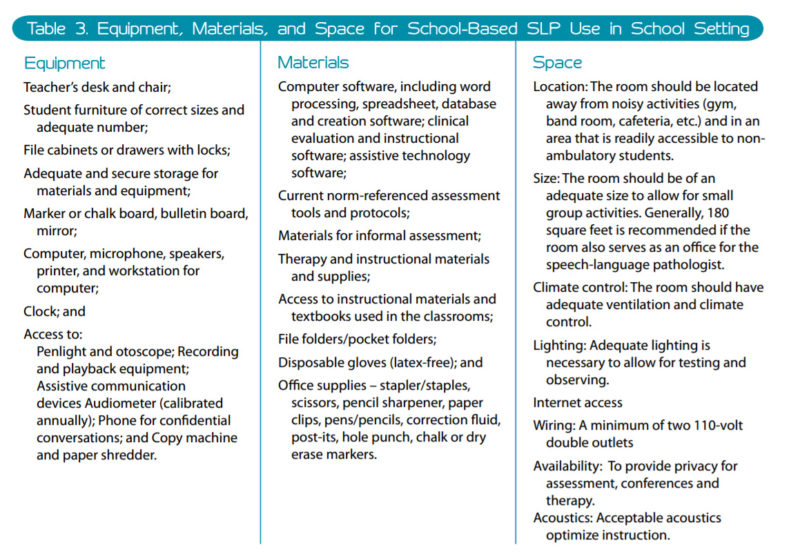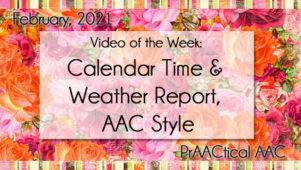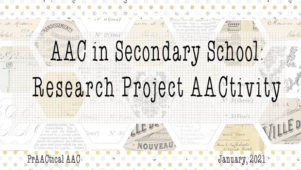Administratively Speaking: Recruiting AAC SLPs (Part 1)

In a great many places, SLPs are in short supply. SLPs with specialized skills, such as those who can support students with AAC needs, are even harder to find. How can program administrators find, and, even more importantly, retain qualified SLPs? In this series, we share a few thoughts on the topic of space.
One of the most meaningful things that an administrator is pretty simple: Ensure that the SLP has appropriate space in which to work.
This basic requirement is frequently overlooked, particularly in educational settings. In schools, the SLP space is sometimes transient (e.g., M/W/F in the psychologist office, T/Th in the OT/PT area), inadequate (e.g., former book storage closet), or inappropriate (e.g., noisy environment, too small to hold groups). Sometimes, the space for SLP work is completely nonexistent. In the past few weeks, I’ve heard from SLPs who are expected to function without a dedicated workspace beyond a file cabinet in someone else’s office.
Let’s be clear: Even when SLPs provide services primarily in the classroom (i.e., push in), this practice is unacceptable. SLPs need space for materials, records, testing, and direct service to students. They need space to collect their thoughts, write IEPs, hold confidential phone calls with families, physicians, and other service providers. They need space to analyze assessment data, write reports, and create AAC materials.
Failing to provide a stable workspace for SLPs sends the wrong message.
- It says: “Your work is less important than the rest of the professional staff.”
- It says: “We don’t believe that your role is central to the success of our students.”
- It says: “We don’t have to. We’re fine with meeting the bare minimum that is required.”
- It says: “Deal with it. We know you have no choice.”
Despite the explanation that space is tight (We know it really is!), despite the hand wringing and sweet apology that comes along with that explanation (We know that you’re a nice person!), despite all of the other wonderful things about that work environment (We know these are great kids!), it is a clear signal that this is a place that undervalues the role of the SLP. Caveat emptor.
Providing adequate and stable space for the SLP is good for students.
- It is good for the kindergartner who is highly distractible and and has some behavioral challenges.
- It is good for the elementary student who learns best in environments rich in visual supports, routine, and predictability
- It is good for the middle school student who comes from an unstable home and craves deep connections in which personal information can be shared.
- It is good for the high school student with self-esteem issues who needs to shine and be recognized.
- It is good for those students who need every second of therapy time, and really miss out when the SLP has to spend 5 minutes of a 30-minute session making the transient space suitable for therapy.
- It is good for students who benefit from the anchor charts and visual supports specific to their targeted goals.
- It is good for students who are sensitive to prompting and correction, particularly if others are present and can overhear/observe.
- It is good for students who learn slowly, and do best when the environment is arranged in a consistent way so that they can independently access materials and know what is expected of them.
- It is good for students who are easily dysregulated and need a thoughtfully organized environment in order to be in a ready-to-learn state.
Beyond doing the right thing for their staff and students, here’s another reason why administrators should ensure adequate space for SLPs: It’s part of the guidelines issued by our national professional organization, the American Speech Language Hearing Association. Here’s what that organization said about the issue.
“Speech-Language Pathology Room: The space provided for speech-language pathology services in a regular school building should be located in the instructional area of the building that houses children of comparable age. It should be located in an area that ensures privacy, confidentiality, and sensitivity to student needs. The room should be used by only one professional at a time and should be designated for the exclusive use of the speech-language pathologist when he or she is scheduled to be in the building. Individual state laws and regulations can dictate where services can be provided in religious private schools; some states allow speech and language services in religious schools to be provided in neutral rooms with no religious icons.
- When services are provided outside the classroom setting, the area should be reasonably exclusive and large enough to provide the full range of evaluation and instructional activities needed to provide services to a caseload. These services may include evaluation and testing of individual students, pull-out treatment for individuals and/or groups, team meetings, and confidential conferences with teachers and parents, as well as activities to prepare for treatment, prepare and maintain assistive technology support, and provide case management services.
- Each speech-language area should be readily accessible to nonambulatory students and should accommodate the special needs of students with disabilities as mandated by the ADA. This includes students who are physically challenged, and students with low vision or neurological problems.
- The facilities should be adequately heated and cooled, lighted and ventilated, and provided with sufficient electrical outlets and computer accessibility.
- Speech-language services should be provided in an environment that ensures student safety and welfare; complies with applicable building and safety codes; and includes universal precautions, infection control, risk management, and emergency preparedness (ASHA, 2002a).”
Need yet another reason to figure out ways to ensure that SLPs have adequate space? Consider this: Failing to do so may put your program in violation of state regulations. In some states, the space requirements for SLPs are delineated by the Department of Education or other agencies. Virginia, for example, states that “Adequate facilities for the many services provided by speech-language pathologists are necessary to meet the IEP requirements of students and to meet IDEA and Americans with Disabilities Act of 1990 regulations” (click here for the full document). The table below provides more specific guidance as to the space requirements

Finding appropriate space for the SLP can be challenging for administrators, but those who adequately address this basic requirement are likely to be more successful at recruiting and retaining qualified SLPs. Do you have suggestions for program administrators? Let us know so that we can include them in other posts in this this series.
Filed under: Featured Posts, PrAACtical Thinking
Tagged With: administration, administrator, recruitment, school, space
This post was written by Carole Zangari





4 Comments
Thanks for speaking up for us! Space has been a significant problem literally everywhere I have worked over the last 19 years.
I appreciate you sharing information on this disability and recruiting so many people to help!
As an itinerant teacher for students who are D/HH, we run into the same issues. Some schools are AWESOME and make it happen; other times, it feels like we’re being a nuisance begging for some quiet space to do auditory training and other lessons with our students. I have worked in custodial closets, at a table in a busy hallway, art supply closet, etc. Flexibility is paramount with our jobs but sometimes the environment in which we have to work is not conducive to student growth (or our sanity!).
Great post!
Thanks, Lisa! I am hoping to create a series of posts like this that SLPs can share with their administrators. I find that sometimes they are just so busy, so stressed, and so torn between competing priorities, that attention to SLP space is not on their radar in any serious way. As SLPs, we tend to ‘make it work,’ which is terrific in one sense but can work to our disadvantage when admins rely on us to just cope with whatever we’re given. We need to learn to ‘squeak’ a little louder, more consistently, and with a good deal of persistence to get some of the precious ‘grease’ that will allow us to better serve the students.